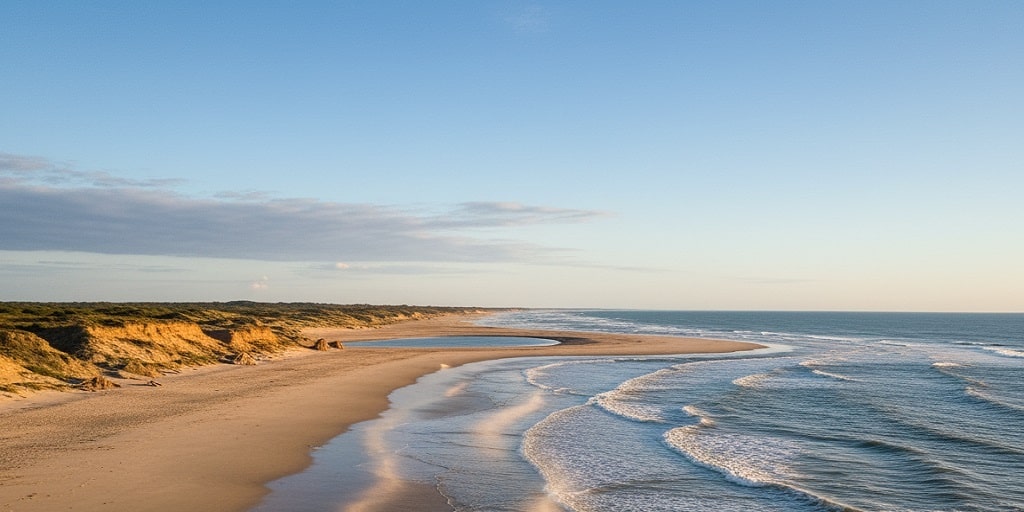
Have you ever stopped on a beach and observed the shoreline? From the cliffs of the South West to the sandy dunes of East Anglia, all of these coastlines are constantly moving. This restructuring of waves is not random but the result of a coastal process, known as longshore drift.
But learning the longshore drift definition isn't just about passing an exam paper. Instead, it shows how wave energy moves sediment, shapes coastlines, and influences both erosion and coastal engineering.
With that in mind, let’s understand the systematic movement of sediment along our shores.
Longshore drift is often misunderstood as a simple erosion. But it’s actually a two-step wave energy transportation process. The drift begins when incoming waves approach the shore at an oblique angle, which is determined by the direction of the prevailing wind.
This further results in two distinct, sequential motions, such as:
When a wave breaks, it drives water up the beach at an angle. The sediment moves diagonally across the shore in the same direction, known as the swash.
As the water loses energy, gravity pulls it directly back down the beach slope to the sea. The return flow, which is always perpendicular to the shoreline, is known as the backwash.
The repeated action of a diagonal push-up, followed by a straight pull-down, creates the characteristic zig-zag motion. This continuous transfer of material along the coast in one dominant direction is the net effect of longshore drift.
The combined zig-zag motion results in the net transportation of material along the coast in a single, predictable direction, making longshore drift a major transfer process in the coastal system.
The overall direction and the magnitude, speed and volume of the drift are controlled by two distinct factors:
The drift direction is explicitly determined by the prevailing wind, which dictates the angle at which the most powerful waves hit the coast. For much of the UK, the dominant south-westerly winds mean that material is moved from west to east along the coastline.
The speed and volume of material transported depend largely on wave strength and the fetch. Fetch is the distance over which the wind has continuously blown to generate those waves. A longer fetch usually results in more powerful waves and faster sediment movement.
This consistent direction is important for geographers and engineers alike. It allows them to evaluate sediment budgets and predict where beaches will lose material through erosion and where new landforms will form through deposition.
Longshore drift plays a major role in forming coastal depositional landforms. Deposition occurs when the coastline changes direction, forcing the drift to continue out into open water, or when water loses energy, such as at a river mouth or estuary.
The most well-known result is the formation of a spit. It is a long ridge of sand or shingle connected to the land at one end and stretching out into the sea. The Spurn Head in Yorkshire and Hurst Spit in Hampshire are the best examples of it.
If a spit links two headlands, it forms a bar, which either isolates a freshwater lagoon or marsh area behind it.
While text and diagrams can clarify the zig-zag effect of longshore drift, nothing quite matches seeing this process in real time. To further help you understand how swash and backwash work in sequence, we've integrated a concise, step-by-step video explanation directly from the experts at HRB Education.
This video breaks down the full mechanism, detailing:
This visual guide is an excellent way to grasp the concepts we've covered, helping you move from memorising terms to understanding coastal mechanics.
Video: Longshore Drift Explained: Understand Coastal Processes | GCSE Geography Help By HRB Education
It's one thing to memorise the terms, but quite another to apply this concept in an examination context. What matters is the ability to show how longshore drift shapes coastal landforms and why those changes occur. Strong answers link process, energy, and evidence through well-chosen case studies.
At HRB Education, we go beyond memorising terms. Our tuition and home-school programmes help students turn complex topics like longshore drift into clear, analytical explanations that meet the expectations of UK academia.
Get in touch with us to create a personalised curriculum for your GCSE/A-Level exam.
Sign up for the latest insights and updates.